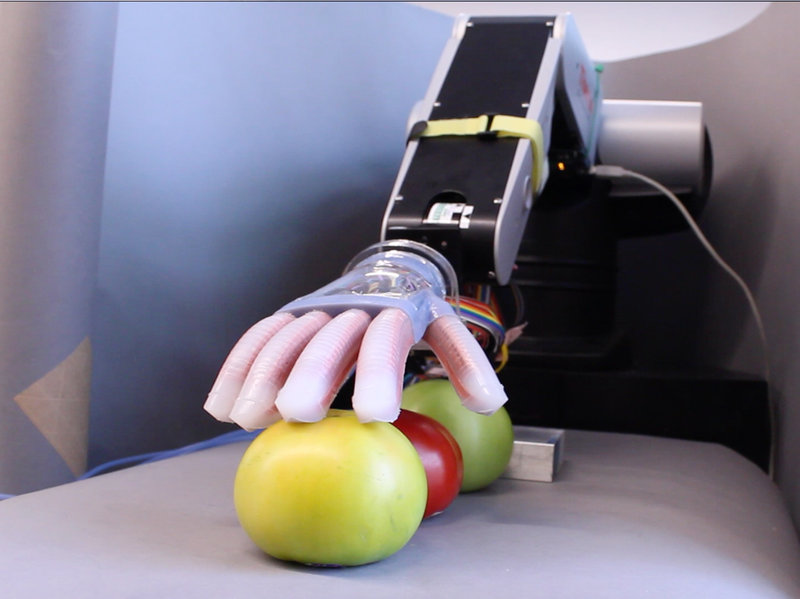Jan 9 2017
3D printing is enabling strong advances in the field of soft robotics. New research from Cornell University has created robotic hands that have sensory feelings. Known as the Gentle Bot, the soft robotic hand was developed in order to create a structure that can sense external objects and can even select a ripe tomato.
 Gif shows the Gentle Bot pressing tomatoes in order to pick the ripe one. Images via Science Magazine.
Gif shows the Gentle Bot pressing tomatoes in order to pick the ripe one. Images via Science Magazine.
How they did it
The team at Cornell published the paper titled ‘Optoelectronically innervated soft prosthetic hand via stretchable optical waveguides’ in Science Robotics. The paper provides details of how the robotic hand was produced and the results of testing. Stretchable optical waveguides were used in the prosthetic hand. The device was created using soft lithography and a Stratasys Objet 30 Polyjet 3D printer. The Objet 30 was used to 3D print molds for the waveguides.
Gentle Bot senses its surroundings through waveguides, which contain LED light inside the fingers. These tubes use light waves to determine the robot’s surroundings by analyzing how the light interacts with external objects. The Gentle Bot was relatively easy to produce through use of 3D printing and soft lithography and the manufacturing techniques meant it was cheaper than normal soft robotic projects. One of the researchers working on the project, Huichan Zhao, believes the arm could be replicated for as little as $50. Using 3D printing in this manner also freed the researchers from lengthy delays that might be associated with prototyping via traditional methods.
3D printed prosthetics
The Gentle Bot has particular significance in the field of prosthesis given that this is an area that frequently uses 3D printing. Several organizations are currently creating prosthesis with 3D printers for amputees who need them most. One example is the Enable Community Foundation who are currently helping amputees in Haiti. Unfortunately however, prosthesis are currently unable to bring the sense of feeling back amputees and primarily provide practical functionality. In the future, perhaps this technology will allow for prosthesis to advance in this way.
What’s special about this robot?
The Gentle Bot is significant because of the way it was produced, but also, because of the fact this process enabled the team to place the sensors inside the device rather than externally. Lead author of the paper, Huichan Zhao spoke about this significance saying,
Most robots today have sensors on the outside of the body that detect things from the surface. Our sensors are integrated within the body, so they can actually detect forces being transmitted through the thickness of the robot, a lot like we and all organisms do when we feel pain, for example.
Elsewhere in robotics, during this year’s Chaos Communication Congress an engineer revealed plans to use candy as an engineering material to perhaps create edible robots. Let’s hope these two technologies aren’t incorporated together creating candy robots that can feel themselves being devoured.